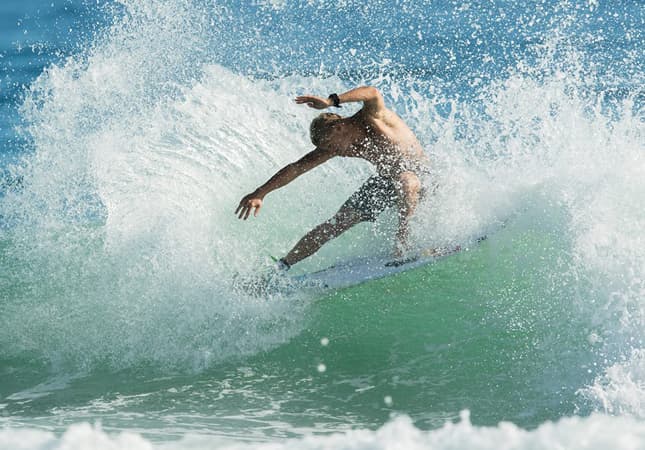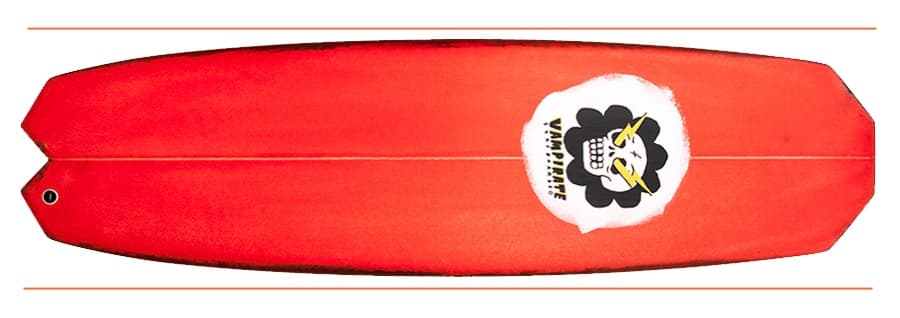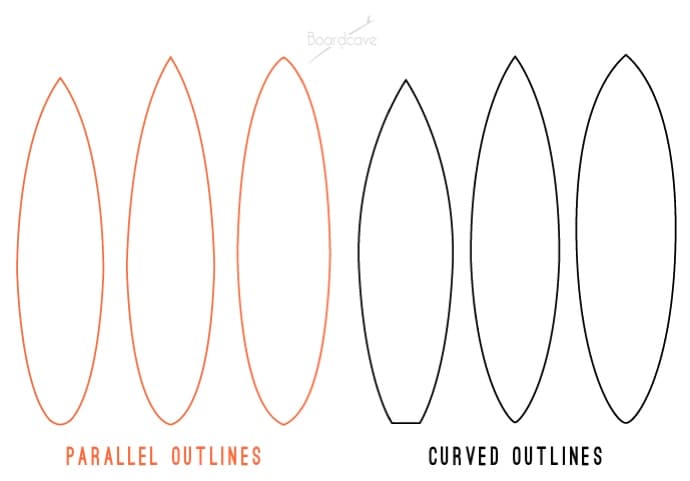Surfboard Outlines
What kind of surfboard shapes are there?
In previous articles, we talked about surfboard design and how different aspects can affect the performance of your board. We’ve already seen
how your surfboard tail, nose and rails can affect your performance. What we didn’t go over in the article however was the general outline of the board itself.
The outline (like many other factors) directly impacts how your board is going to perform. By the outline, what we mean, is the overall shape of the board and how the interaction of the different noses, rail and tails, influences the general outline and therefore performance.
 Mick Fanning loves the outline of his Ducks Nuts.
Mick Fanning loves the outline of his Ducks Nuts.
There are 3 main outlines that we will discuss to keep things simple. Of course, there are an unlimited number combinations and variations available, but we want to keep this relatively simple for now. Those 3 outlines are, a predominately parallel outline, a curved outline and a hybrid style outline.
All three can be found in any number of different styles of boards available, from
high performance shortboards, to stubbies,
mid lengths and
longboards.
1. Parallel Outlines
First up, the predominately parallel outline, can be found in any style of board, from longboards to shortboards and everything in-between. This outline features a straighter elongated template running the length of the board.
Not to be taken too literally as a term since there is some curve in most boards, but used more as a reference to a longer, straighter rail. The Surf and Destroy by
Vampirate Surfboards is a good example of an extreme parallel outline. With this board, the nose is almost chopped so the parallel rail line extends almost all the way from the tail to the tip.
 You can see how the outline is almost parallel with the stringer for a large portion of the ‘curve’ on this Surf and Destroy model.
You can see how the outline is almost parallel with the stringer for a large portion of the ‘curve’ on this Surf and Destroy model.
Parallel outlines gives your board a little more speed down the line. As a result, your turns will have to be more drawn out as it’ll stiffen up your turning radius. This design works well on nose riding logs, fishes and Simmons style of boards. It offers nice trim and more speed along the face of a wave as there is more surface area under the board and in or on the water.
A performance orientated longboard will have sections of the rail that have strong parallel lines, usually around the center or wide point, then tapper into more of a curve in the nose and tail. This combination will allow the surfer to stand in the middle of the board for speed when trimming down the line, then step back on the tail and wrap a harder turn. As for the nose, the curve will help when re-entering from a turn off the top of the wave or when dropping in late, keeping the nose of the board from diving and will help carry speed through the curve of the wave. For more info on longboards, check out our dedicated article,
So You're Thinking of a Longboard.
Extreme parallel outlines can hurt a shortboards performance though, as they generally need to be able to turn tighter in the pocket of a wave. The parallel lines on a shortboard will generally be after the mid section of the board, running towards the tail. Combine this with a the curve in the nose and you can find a happy medium between being able to get turns in wile still being able to get up an a plane and generate down the line speed when surfing off the back foot.

2. Curved Outlines
A curved outline is just what it sounds like. A continuous curve from tip to tail. They are most common on shortboards, some step-ups and hybrids, etc. where you want the board to have a tighter turning radius. This comes in especially handy for longer performance shortboards like a
step up or semi gun, where the length can cause the board to feel a little stiff.
Other boards you commonly find a curved outline on are the shorter, flatter rocker shortboards or
hybrids. The flat rocker gives you all the speed you need, so a curved outline can help you make tight turns in a small pocket.
The SUPERquadrophina by
SUPERbrand Surfboards is a good example of a board having a curved outline. The wide point is pushed forward a bit and it has lower rocker. This helps you get into waves early and carry speed down the line, where the continuous curve in the outline will help you to wrap those turns in a smaller radius, perfect for surfing in the pocket.
The
Polyphonic by
Album Surfboards is another example, but is a board that will handle a little more size. Lower rocker to keep your speed up, with a nice curved outline to wrap hard turns either on the face or in the pocket.
 This Quadrofinia model combines a curved outline with a lower rocker, and wider forward volume to get you into waves earlier.
This Quadrofinia model combines a curved outline with a lower rocker, and wider forward volume to get you into waves earlier.
3. Hybrid Outline
A hybrid outline is essentially when your board features a blend of elements from both a parallel outline and a curved outline throughout the overall template. This outline can be found on any type of board, usually featuring strong parallel lines near the wide point of the board, blending into elongated curves through the nose, tail or both.
A good example of a hybrid outline is something like the Skeleton Key by
DHD Surfboards. It may be hard to notice with the naked eye, but you can see a continuous curve running down from the nose to about the wide point. The rails become a little straighter around the wide point, or parallel, and run down to a slight “hip” just in front of the fins where the tail is able to be pulled in. This gives you a super versatile shortboard that can handle almost anything.
The curve in the nose will help guide you through your turns, the parallel rails from the wide point down help give you speed down the line and the hip, pulling in the tail, will allow you to jam in tight turns right on the spot.
 This Skeleton Key is known for it’s versatility with a lot of this attributed to it’s interesting outline. Check out the change in the outline between the nose to the hip and through the tail.
This Skeleton Key is known for it’s versatility with a lot of this attributed to it’s interesting outline. Check out the change in the outline between the nose to the hip and through the tail.
Summary
We keep saying it in our other articles but we have to say it again…as with everything surfboard related, there is no right or wrong. There is not one way or one design that is the end all and be all.
There are so many elements in play that can affect a board's performance. It is the blending of these elements to get the desired effects you are looking for in a board that is the trick.
Surfboard shapers have to think about how each of these elements work on their own in order to combine them with others to get the results they are looking for. As stated above, a curvier outline combined with flat rocker to get a board that is fast yet turns well. And in that particular case, those are only two of the many other elements that will be in that particular board. Different concave configurations, the overall width of the board, the general nose and tail shape, the thickness, foam distribution and overall volume of your surfboard etc etc, are all major players in how your board will perform.
That’s what makes surfboards and surfboard design so profound. There are endless possibilities and refinements happening everyday.
Make sure you check out our
surfboard volume calculator, the
Board Engine, to find a range of boards from the world's best shapers at the top of their crafts.
Amidst this exploration, don't overlook the smaller details – from the precision of a
surfboard ankle strap to the safeguarding prowess of
surfboard travel covers, including the essential protection provided by
surf ear plugs.





















